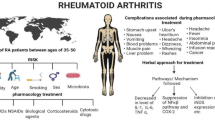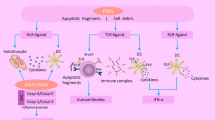Abstract
Background and aims
Anti-TNF-α antibodies are very effective in the treatment of acute Crohn’s disease, but are limited by the decline of their effectiveness after repeated applications. The stinging nettle leaf extract, IDS 30, is an adjuvant remedy in rheumatic diseases dependent on a cytokine suppressive effect. We investigated the effect of IDS 30 on disease activity of murine colitis in different models.
Methods
C3H.IL-10−/− and BALB/c mice with colitis induced by dextran sodium sulphate (DSS) were treated with either IDS 30 or water. Mice were monitored for clinical signs of colitis. Inflammation was scored histologically, and faecal IL-1β and mucosal cytokines were measured by ELISA. Mononuclear cell proliferation of spleen and Peyer’s patches were quantified by 3H-thymidine.
Results
Mice with chronic DSS colitis or IL-10−/− mice treated with IDS 30 clinically and histologically revealed significantly (p<0.05) fewer signs of colitis than untreated animals. Furthermore, faecal IL-1β and mucosal TNF-α concentrations were significantly lower (p<0.05) in treated mice. Mononuclear cell proliferation after stimulation with lipopolysaccharide was significantly (p<0.001) reduced in mice treated with IDS 30.
Conclusions
The long-term use of IDS 30 is effective in the prevention of chronic murine colitis. This effect seems to be due to a decrease in the Th1 response and may be a new therapeutic option for prolonging remission in inflammatory bowel disease.





Similar content being viewed by others
References
Van Deventer SH (1997) Tumour necrosis factor and Crohn’s disease. Gut 40:443–448
Breese EJ, Michie CA, Nicholls SW, Murch SH, Williams CD, Domizio P et al (1994) Tumor necrosis factor alpha-producing cells in the intestinal mucosa of children with inflammatory bowel disease. Gastroenterology 106:1455–1466
Braegger CP, Nicholls SW, Murch SH, Stephens S, MacDonald TT (1992) Tumour necrosis factor alpha in stool as a marker of intestinal inflammation. Lancet 339:89–91
Targan SR, Hanauer SB, van Deventer SJ, Mayer L, Present DH, Braakman T et al (1997) A short-term study of chimeric monoclonal antibody cA2 to tumor necrosis factor alpha for Crohn’s disease. Crohn’s disease cA2 Study group. N Engl J Med 337:1029–1035
Present DH, Rutgeerts P, Targan S, Hanauer SB, Mayer L, van Hogezand RA et al (1999) Infliximab for the treatment of fistulas in patients with Crohn’s disease. N Engl J Med 340:1398–1405
Van Deventer SJH (2002) Anti-tumour necrosis factor therapy in Crohn’s disease: where are we now? Gut 51:362–363
Noman M, Baert F, D’Haens G et al (2001) HACA formation after infliximab (remicade) treatment in Crohn’s disease is clearly associated with infusion reactions. Gastroenterology 120:A69
Baert F, Noman M, Vermeire S, Van Assche G, Haens G, Carbonez A et al (2003) Influence of immunogenicity on the long-term efficacy of infliximab in Crohn’s disease. N Engl J Med 348:601–608
Keane J, Gershon S, Wise RP, Mirabile-Levens E, Kasznica J, Schwieterman WD et al (2001) Tuberculosis associated with infliximab, a tumor necrosis factor-α neutralizing agent. N Engl J Med 345:1098–1104
Hanauer SB, Feagan BG, Lichtenstein GR, Mayer LF, Schreiber S, Colombel JF et al (2002) Maintenance infliximab for Crohn’s disease: the ACCENT I randomised trial. Lancet 359:1541–1549
Sandborn WJ, Hanauer SB, Katz S, Safdi M, Wolf DG, Baerg RD et al (2001) Etanercept for active Crohn’s disease: a randomized, double-blind, placebo-controlled trial. Gastroenterology 121:1088–1094
Vasiliauskas EA, Kam LY, Abreu-Martin MT, Hassard PV, Papadakis KA, Yang H et al (1999) An open-label pilot study of low-dose thalidomide in chronically active, steroid-dependent Crohn’s disease. Gastroenterology 117:1278–1287
Bauditz J, Wedel S, Lochs H (2002) Thalidomide reduces tumour necrosis factor alpha and interleukin 12 production in patients with chronic active Crohn’s disease. Gut 50:196–200
Sabate JM, Villarejo J, Lemann M, Bonnet J, Allez M, Modigliani R (2002) An open-label study of thalidomide for maintenance therapy in responders to infliximab in chronically active and fistulizing refractory Crohn’s disease. Aliment Pharmacol Ther 16:1117–1124
Podolsky DK (2002) Inflammatory bowel disease. N Engl J Med 347:417–429
Rutgeerts P (2002) A critical assessment of new therapies in inflammatory bowel disease. J Gastroenterol Hepatol 17:S176–S185
Teucher T, Obertreis B, Ruttkowski T, Schmitz H (1996) Cytokine secretion in whole blood of healthy subjects following oral administration of Urtica dioica L. plant extract. Arzneimittelforschung 46:906–910
Obertreis B, Ruttkowski T, Teucher T, Behnke B, Schmitz H (1996) Ex-vivo in-vitro inhibition of lipopolysaccharide stimulated tumor necrosis factor-alpha and interleukin-1 beta secretion in human whole blood by extractum urtica dioicae foliorum. Arzneimittelforschung 46:389–394
Riehemann K, Behnke B, Schulze-Osthoff K (1999) Plant extracts from stinging nettle (Urtica dioica), an antirheumatic remedy, inhibit the proinflammatory transcription factor NF-kappaB. FEBS Lett 442:89–94
Klingelhoefer S, Obertreis B, Quast S, Behnke B (1999) Antirheumatic effect of IDS 23, a stinging nettle leaf extract, on in vitro expression of T helper cytokines. J Rheumatol 26:2517–2522
Cooper HS, Murthy SN, Shah RS, Sedergran DJ (1993) Clinicopathologic study of dextran sulphate sodium experimental murine colitis. Lab Invest 69:238–249
Elson CO, Sartor RB, Tennyson GS, Riddell RH (1995) Experimental models of inflammatory bowel disease. Gastroenterology 109:1344–1367
Konrad A, Mähler M, Flogerzi B, Varga L, Kalousek M, Lange J et al (2003) Amelioration of murine colitis by feeding a solution of lysed E. coli. Scand J Gastroenterol 38:172–179
Lindsay JO, Ciesielki CJ, Scheinin T, Hodgson HJ, Brennan FM (2001) The prevention and treatment of murine colitis using gene therapy with adenoviral vectors encoding IL-10. J Immunol 15:7625–7633
Neurath MF, Petterson S, Meyer zum Buschenfelde KH, Strober W (1996) Local administration of antisense phosphorothioate oligonucleotides to the p65 subunit of NF-kappaB abrogates established experimental colitis in mice. Nat Med 2:998–1004
Myers KJ, Murthy S, Flanigan A, Witchell DR, Butler M, Murray S et al (2003) Antisense oligonucleotide blockade of tumor necrosis factor-α in two murine models of colitis. J Pharmacol Exp Ther 304:411–424
Schulze-Tanzil G, de Sousa P, Behnke B, Klingelhoefer S, Scheid A, Shakibaei M (2002) Effects of the antirheumatic remedy hox alpha—a new stinging nettle leaf extract—on matrix metalloproteinases in human chondrocytes in vitro. Histol Histopathol 17:477–485
Broer J, Behnke B (2002) Immunosuppressant effect of IDS 30, a stinging nettle leaf extract, on myeloid dendritic cells in vitro. J Rheumatol 29:659–666
Madsen KL, Doyle JS, Jewell LD, Tavernini MM, Fedorak RN (1999) Lactobacillus species prevents colitis in interleukin 10 gene-deficient mice. Gastroenterology 116:1107–1114
Schreiber S, Campieri M, Colombel JF, van Deventer SJH, Feagan B, Fedorak R et al (2001) Use of anti-tumour necrosis factor agents in inflammatory bowel disease. European guidelines for 2001–2003. Int J Colorectal Dis 16:1–11
D’Haens G (2003) Anti-TNF therapy for Crohn’s disease. Curr Pharm Des 9:289–294
Netea MG, van Deuren M, Kullberg BJ, Cavaillon JM, Van der Meer JW (2002) Does the shape of lipid A determine the interaction of LPS with toll-like receptors? Trends Immunol 23:135–139
Schreiber S, Nikolaus S, Hampe J, Hämling J, Koop I, Groessner B et al (1999) Tumour necrosis factor α and interleukin 1β in relapse of Crohn’s disease. Lancet 353:459–461
Arnott IDR, Watts D, Ghosh S (2002) Review article: is clinical remission the optimum therapeutic goal in the treatment of Crohn’s disease? Aliment Pharmacol Ther 16:857–867
Feagan BG, Fedorak RN, Irvine EJ, Wild G, Sutherland L, Steinhart AH et al (2000) A comparison of methotrexate with placebo for the maintenance of remission in Crohn’s disease. North American Crohn’s Study Group Investigators. N Engl J Med 342:1627–1632
Loher F, Schmall K, Freytag P, Landauer N, Hallwachs R, Bauer C et al (2003) The specific type 4 phosphodiesterase inhibitor mesopram alleviates experimental colitis in mice. J Pharmacol Exp Ther 305:549–556
Dieleman LA, Ridwan BU, Tennysonn GS, Beagley KW, Bucy RP, Elson CO (1994) Dextran sulfate sodium-induced colitis occurs in severe combined immunodeficient mice. Gastroenterology 107:1643–1652
Acknowledgements
This study was supported by the Swiss National Science Foundation (SNF 31-59031.99), by a grant to Astrid Konrad from the Deutsche Forschungsgemeinschaft (KO-2228/2-1) and by Strathmann AG, Hamburg, Germany.
Author information
Authors and Affiliations
Corresponding author
Rights and permissions
About this article
Cite this article
Konrad, A., Mähler, M., Arni, S. et al. Ameliorative effect of IDS 30, a stinging nettle leaf extract, on chronic colitis. Int J Colorectal Dis 20, 9–17 (2005). https://doi.org/10.1007/s00384-004-0619-z
Accepted:
Published:
Issue Date:
DOI: https://doi.org/10.1007/s00384-004-0619-z




